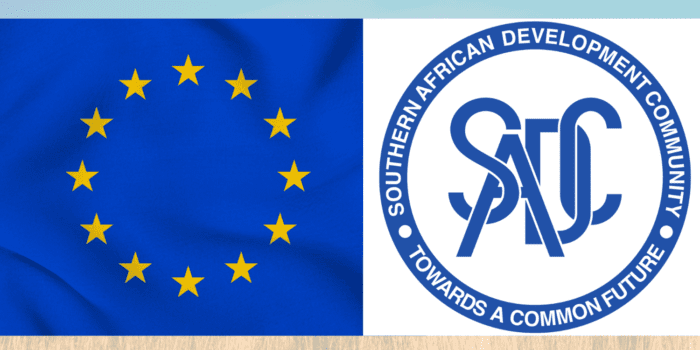The agreement between the European Union (EU) and the Southern African Development Community (SADC)
Is a crucial step towards deepening trade and economic ties between the two regions. The agreement aims to create a free trade area between the EU and the SADC countries, which would facilitate the movement of goods, services, and investments between the two regions.

The history of the Economic Partnership Agreement (EPA) between the European Union (EU) and the Southern African Development Community (SADC) traces back to the Cotonou Agreement of 2000, a broad framework for EU-Africa relations. Under the Cotonou Agreement, it was agreed that a new form of trade cooperation, known as EPAs, should be established between the EU and African, Caribbean, and Pacific (ACP) countries. The goal of these agreements was to encourage sustainable development and poverty reduction in ACP countries by fostering trade and investment.
Negotiations for the SADC-EU EPA began in 2004 and involved a group of SADC member states: Botswana, Lesotho, Mozambique, Namibia, South Africa, Swaziland (now Eswatini), and Angola (which has observer status). These negotiations were complex due to various issues such as the differing levels of development among SADC countries and the challenge of balancing trade liberalization with the need to protect sensitive sectors.
The SADC region is made up of 16 countries, including Angola, Botswana, Comoros, Democratic Republic of Congo, Eswatini, Lesotho, Madagascar, Malawi, Mauritius, Mozambique, Namibia, Seychelles, South Africa, Tanzania, Zambia, and Zimbabwe. The EU-SADC agreement is expected to increase trade and investment flows between the two regions and promote economic growth and development.
The agreement was signed in 2016, after more than a decade of negotiations between the two parties. It covers a range of issues, including trade in goods, services, and investments, as well as intellectual property rights, competition, and sustainable development.
The agreement
Under the agreement, the EU will gradually eliminate tariffs on 98.7% of goods imported from SADC countries over a period of 15 years. In return, SADC countries will reduce or eliminate tariffs on 86% of imports from the EU. The agreement also includes provisions for protecting intellectual property rights, promoting competition, and promoting sustainable development.
The EU-SADC agreement is expected to have a significant impact on the economies of both regions. For SADC countries, the agreement will provide new opportunities to export goods and services to the EU, which is the world’s largest single market. It will also help to attract investment from European companies and promote technology transfer and skills development.
For the EU, the agreement will provide access to a growing market of more than 300 million people in the SADC region, which is rich in natural resources and has a growing middle class. It will also help to diversify the EU’s trade relationships and reduce its dependence on traditional trading partners.
Overall, the EU-SADC agreement represents an important milestone in the economic partnership between Europe and Africa. It is a testament to the growing importance of Africa as a key player in the global economy and the EU’s commitment to deepening its relationship with the continent.
Key aspects of this agreement include:
- Market Access: The EU grants full duty-free, quota-free access to products from SADC EPA countries, while these countries have more flexibility and longer timelines for opening their markets to EU products. This ensures the agreement is beneficial to the development of SADC nations.
- Regional Integration: The agreement aims to promote regional integration and economic cooperation among SADC member states.
- Development Cooperation: The EU provides development aid to SADC countries to help them effectively benefit from the EPA, in areas such as infrastructure development, capacity building, and improving sanitary and phytosanitary standards.
- Protective Measures: The agreement includes safeguards that allow SADC countries to shield their domestic industries from serious harm due to a surge in imports. These protective measures are designed to protect local industries and jobs.
- Dispute Resolution: The EPA establishes clear procedures for resolving disputes that might arise between the EU and SADC countries, helping to ensure fairness and predictability in their trading relationship.
- Human Rights and Sustainable Development: The agreement also upholds the principles of human rights, labor rights, environmental protection, and sustainable development.
Here are some examples:
- Wine: The agreement allows for the export of wine from both the EU and SADC countries. However, the agreement includes provisions for protecting the names of specific wines, such as “Champagne” and “Port”, which can only be used for wines produced in specific regions of France and Portugal, respectively.
- Fisheries: The agreement includes provisions for sustainable fisheries management and the prevention of illegal, unreported, and unregulated fishing. SADC countries are required to implement measures to ensure the sustainability of their fisheries, such as setting quotas and monitoring fishing activities.
- Textiles and clothing: The agreement allows for duty-free access to the EU market for textiles and clothing produced in SADC countries. However, there are specific rules of origin that must be met in order for products to qualify for duty-free treatment. For example, at least 60% of the value of the product must come from SADC countries.
- Agricultural products: The agreement includes provisions for sanitary and phytosanitary measures to ensure the safety of agricultural products traded between the EU and SADC countries. This includes measures to prevent the spread of animal and plant diseases and to ensure food safety.
This EPA represents a shift from previous trade relationships, which were based on unilateral trade preferences, towards a more mutually beneficial partnership. The goal is to boost economic growth and reduce poverty in SADC countries by fostering trade and investment.
Overall, the agreement between the EU and SADC sets out specific conditions for the trade of different products in order to ensure fair and sustainable trade between the two regions.
Some links for more information on the EU-SADC trade agreement:
- European Commission: EU-SADC Economic Partnership Agreement: https://ec.europa.eu/trade/policy/countries-and-regions/regions/southern-african-development-community/
- Southern African Development Community: SADC-EU Economic Partnership Agreement: https://www.sadc.int/our-work/economic-development/trade-and-investment/sadc-eu-economic-partnership-agreement/
- European Parliament: EU-SADC Economic Partnership Agreement: https://www.europarl.europa.eu/legislative-train/theme-a-renewed-agenda-for-research-and-innovation/file-eu-sadc-economic-partnership-agreement
- European External Action Service: EU-SADC Relations: https://eeas.europa.eu/headquarters/headquarters-homepage/1212/eu-sadc-relations_en
- European Investment Bank: Supporting Sustainable Development in Southern Africa: https://www.eib.org/en/stories/sadc-southern-africa-development-community-sustainable-development

Team ProdAfrica
team@prodafrica.com